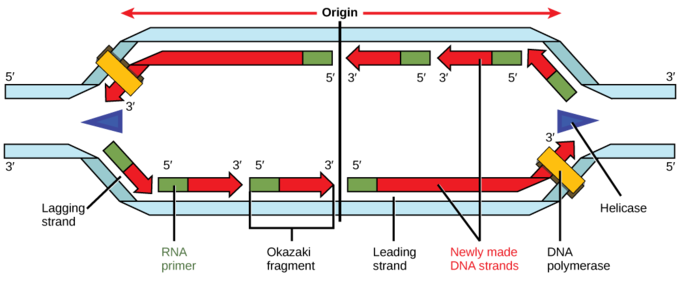DNA replication is the process by which a cell makes an exact copy of its genetic material. In eukaryotic cells, this complex process involves the coordinated actions of several enzymes and proteins. Understanding the steps of DNA replication in eukaryotes is crucial for scientists to comprehend how genetic information is passed from one generation to the next. In this article, we will explore the molecular mechanisms of DNA synthesis and replication accuracy to give you a comprehensive understanding of this fundamental biological process.
- Replication of DNA is a biological process in which DNA makes a duplicate copy of itself from the original one during cell division.
- DNA replication is the most essential part of the inheritance of genetic information that occurs in all living cells.
- The replication process in DNA occurs by the separation of two strands by certain enzymes in which each strand serves as a template in further processes.
- This type of process is referred to as the semiconservative replication process because of the DNA strands after separation act as a template for new DNA molecules for further synthesis.
- During cell division, each DNA molecule must be copied exactly like that of parent molecules to ensure that the identical DNA molecules get included in the two daughter cells. So, each daughter DNA contains one old and one newly synthesized DNA strand.
- After the formation of two daughter DNA copies, its one sequence strand is identical and the other sequence is the copy of the parental DNA.
- The replication process in prokaryotic cells and eukaryotic cells are different as eukaryotic genomes are larger in size and starting replication is much more complex than in prokaryotic replication.
- The origin of the replication site of the prokaryotic genome is specific while the eukaryotic genome contains multiple initiator proteins. The remaining overall process is the same in both the cells although different enzymes are involved.
- The rate of replication of the eukaryotic genome is much slower than prokaryotic replication which is 100 nucleotides per second.

Three steps are involved in the replication of eukaryotic DNA:
- Initiation
- Elongation
- Termination
Initiation of DNA Replication
- The initial step of DNA replication of eukaryotic cells is to find a specific chromosomal location called an origin of replication.
- Eukaryotes like in human, there consists of multiple sites of origin replication therefore, the replication initiation protein identifies and binds to the specific site to the nucleosomes. But in some eukaryotes like in yeast, they have a defined site of replication.
- After binding to a specific origin site, the DNA starts to unwind its double helix structure. This process is carried out by a helicase enzyme that breaks the hydrogen bond between two strands and holds up the complementary bases together.
- Two strands separate and forms a Y-shaped replication fork and keep extending in both the direction until it forms a bubble-shaped known as the replication bubble.
- The replication fork strand serves as a template for the formation of entire new strands of DNA molecule.

Elongation
- The polymerases from the initial protein complex work together and help in the elongation of two daughter strands.
- To initiate the DNA synthesis, primase and DNA polymerase α helps in the addition of DNA nucleotides to the 3’ and 5’ end of the new polynucleotide strand and forms DNA polymerase α-primase complex.
- The primase synthesizes the RNA primers and gets transferred to the polymerase domain where the extension of the DNA base takes place.
- The four nucleotides (A, T, G, or C) complementing the template nucleotide and get added at each specific position.
- After complementing, DNA polymerase helps in the replication of new DNA strands that occurs simultaneously. This is why DNA polymerase is also known as “dimer”.
- As the replication proceeds, the replication fork opens up further and separates at the end.
- The newly synthesized DNA strand with 3’-5’ orientation complementary to the parent strand which forms in a continuous manner is known as the leading strand and the other strand with 5’-3’ orientation are formed in pieces and are known as Okazaki fragments and are in a discontinuous manner also known as lagging strand.
- After the formation of individual strands, RNA primers are removed by DNA polymerase I and are replaced with normal DNA nucleotides.
- The feature of eukaryotic DNA is that it is packaged in chromosomes and are wounded with 8 histone proteins and forms a structure called nucleosomes.
- During replication, the nucleosomes in front of the two replication fork remain unstabilized and later synthesized de novo and assemble onto the daughter strands.
Termination of DNA Replication
- Chromosomes of eukaryotic cells have multiple origins of replication in which each replication origin forms a bubble of duplicated DNA.
- The action of DNA polymerase stops when it reaches a section of the DNA template but cannot catalyze the phosphodiester bond formed between the two segments of the new DNA strands which are then left out.
- The remained unattached section of sugar and phosphate grouped DNA strands are called nicks. To complete the replication process, the nicks need to be connected.
- The enzyme ligase plays a major role in joining the sugar-phosphate backbone at each nick site which makes a long continuous new DNA strand.
- This is the final stage of DNA replication in which the daughter DNA molecules are formed.
